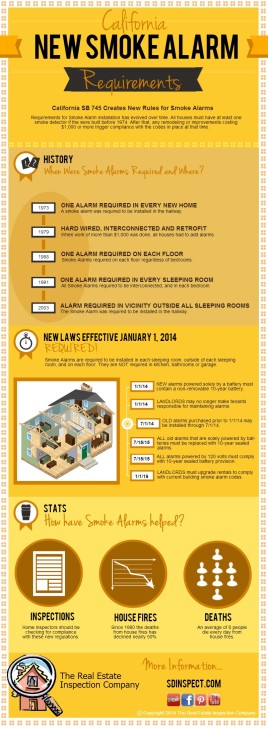Where are Smoke Alarms Required?
Where and When are Smoke Alarms Required?
One of the responsibilities of a home inspector is to check the presence and functionality of smoke alarms in a home. Smoke alarms were required first in 1973. The codes pertaining to smoke alarms have expanded since then.
- In 1973, one smoke alarm was required for the whole home.
- In 1979, code changed to include a required retroactive smoke alarm inspection and hardwired and interconnected alarms when work of more than $1,000 was done on the home.
- In 1988, one smoke alarm was required on every floor of the home.
- In 1991, one smoke alarm was required in every sleeping room.
- In 2003, a smoke alarm was required in the vicinity outside of every bedroom.

- Starting July 1, 2014, any smoke alarm installed that is solely battery powered MUST contain a non-removable battery that is rated to last 10 years.
- An exemption exists for battery powered smoke alarm installed prior to July 1, 2014, but that expires on July 15, 2014.
- On July 1, 2015, ALL old smoke detectors that are solely powered by batteries must be replaced with those that contain a sealed battery that is rated to last 10 years.
- Effective July 1, 2015, all smoke alarms powered by 120 VAC or battery must comply with the provisions of having a label showing the date of installation & manufacture.
- SB 745 also requires that for all dwelling units intended for human occupancy, for which a building permit is issued on or after January 1, 2014, for alterations, repairs, or additions exceeding one thousand dollars ($1,000), the permit issuer shall not sign off on the completion of work until the permittee demonstrates that all smoke alarms required for the dwelling unit are devices approved and listed by the Office of the State Fire Marshal pursuant to Health and Safety Code Section 13114.
- As of January 1, 2014, landlords cannot make the tenant responsible for testing or maintaining the smoke alarms. It is the landlord’s responsibility.
About the author: Philippe Heller is the president of The Real Estate Inspection Co. The company is the largest home inspection company serving San Diego, Orange County, and Temecula since 2004.



